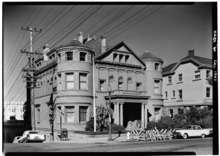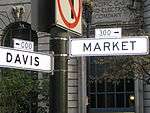Jackson Street (San Francisco)
Jackson Street is a street in San Francisco, California, running through the Pacific Heights, Nob Hill, Chinatown and Jackson Square districts of the city. It runs between Pacific Avenue and Washington Street, beginning at Arguello Boulevard to the south of the Presidio Golf Course and ending at Drumm Street, to the west of Pier 3, near Sydney G. Walton Square.
History
In the fall of 1863, Mohave chief Irataba created a storm when he walked down Jackson Street, dressed in what Arthur Woodward described as "the full civilized costume" typical of European Americans, which Irataba soon preferred to traditional Mohave clothing.[1] The press documented his every movement and wrote extensively about his physical size and strong features.[2] In February 1894, the two cable car lines on the street were extended.[3] In the 1990s, the Jackson Street Boys criminal gang gained notoriety.
The section of Jackson Street between Montgomery and Sandsome Avenues is of historical interest.[4] It contains several 19th century buildings that were built after the 1851 city fire and survived the 1906 earthquake.[5] The Lucas, Turner & Co. Bank, also known as the "Sherman's Bank" was opened by William Tecumseh Sherman on the corner of Jackson and Montgomery in 1854.[4] Ghirardelli Chocolate operated a factory in Nos. 415-431 between 1853 and 1894. The Hotaling Whiskey Warehouse, at Nos. 451-455, was built in 1866. In the aftermath of the earthquake, the Army decided not to demolish the buildings on this block for fear of detonating the barrels of whiskey in the warehouse, which would cause an explosion.[5] The Hotaling Building at 466 Jackson Street was built in 1866.
Notable landmarks

Notable buildings along the road from east to west include the Eureka Theatre, International Hotel Manilatown Center, Golden Gate Fortune Cookie Factory, the San Francisco Chinese Hospital, Han Palace Antique and Art Center, Jackson Market, the German Consulate, Jackson Court, the San Francisco Public Montessori, Calvary Presbyterian Church, Whittier Mansion and San Francisco University High School.[6] In addition, the Academy of Art University owns and operates a building on the street for graduate apartments.[7]
References
- Woodward 1953, pp. 61–2.
- Mifflin 2009, p. 178.
- Echeverria & Rice 2005, p. 31.
- Richards 2007, p. 264.
- GSA 2006, p. 21.
- Google (11 March 2015). "Jackson Street (San Francisco)" (Map). Google Maps. Google. Retrieved 11 March 2015.
- "Academy of Art University Campus Map" (PDF). academyart.edu. Academy of Art University. Retrieved 18 April 2017.
Bibliography
- Echeverria, Emiliano; Rice, Walter (2005). San Francisco's Powell Street Cable Cars. Arcadia Publishing. ISBN 978-0-7385-3047-5.CS1 maint: ref=harv (link)
- Mifflin, Margot (2009). The Blue Tattoo: The Life of Olive Oatman. University of Nebraska Press. ISBN 9780803211483.CS1 maint: ref=harv (link)
- Woodward, Arthur (January 1953). "Irataba: Chief of the Mohave". Plateau. Northern Arizona Society of Science and Art; Museum of Northern Arizona. 25 (3).CS1 maint: ref=harv (link)
- Prentice, Carol, ed. (2006). 1906 San Francisco Earthquake Centennial Field Guides: Field Trips Associated with the 100th Anniversary Conference, 18-23 April 2006, San Francisco, California. Geological Society of America. ISBN 978-0-813-70007-6.
- Richards, Rand (2007). Historic San Francisco: A Concise History and Guide. Heritage House Publishers. ISBN 978-1-879-36705-0.CS1 maint: ref=harv (link)
